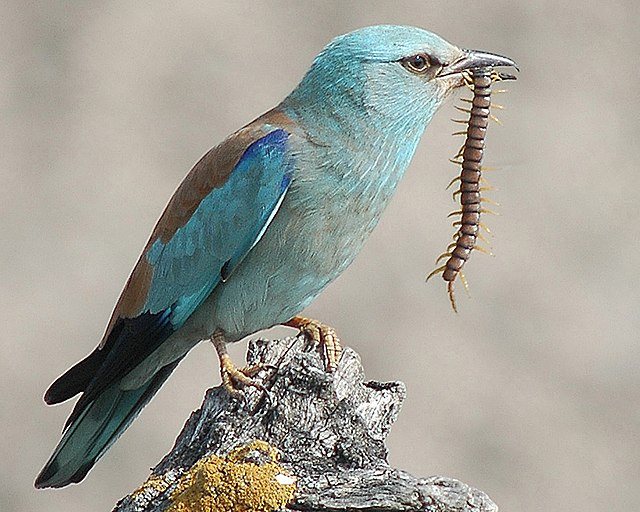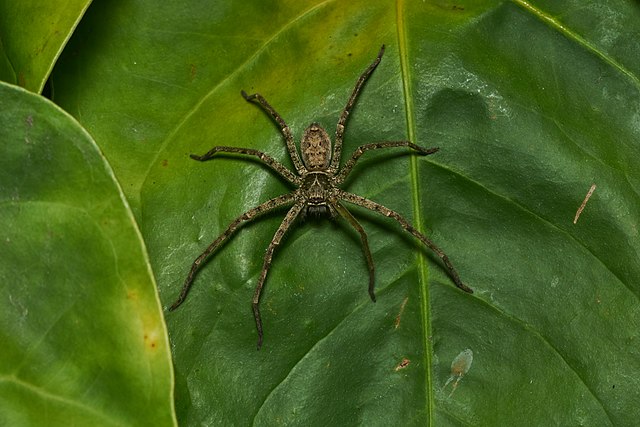Centipedes that live outdoors are always at risk of being prey to a number of different animals, insects, amphibians, mammals, and more.
They are easy prey, even though they are fast movers and will run and hide under rocks, logs, and leaf litter.
Table of Contents
What Eats Centipedes
We all know that centipedes are excellent at keeping pests out of the home or garden, such as spiders, flies, and other insects. At the same time, they are at risk of being eaten by a number of different animals, especially when living outdoors.
The animals that eat centipedes include:
1. Birds
The majority of wild birds will eat a centipede, especially the smaller ones. Wild birds prey on a number of different insects from spiders and crickets to centipedes.

Interesting Fact: But while centipedes are prey to hungry birds, there is the Phillip Island centipede (Cormocephalus coynei) that can eat more than three thousand five hundred seabird chicks every year. This occurs on a tiny island called Phillip Island, which is part of the South Pacific Norfolk Islands.
2. Spiders

Some spider species will eat the younger and smaller centipedes. Centipedes are in a vulnerable position when they live outdoors, making them easy prey for spiders, such as the wolf spider or tarantula. These spiders create burrows, which make a passing centipede an easy meal.
At the same time, house centipedes, which are common in North America, are often attracted to a home because of the food it provides, such as spiders. Your house spider will eat small spiders that have taken up residence in your home.
3. Mongooses

Mongooses are small carnivorous mammals, they are native to Africa, Asia, and southern Europe. They feed mostly on insects, but are opportunistic eaters and will also eat earthworms, birds, rodents, lizards, centipedes, and any pet food you may leave out for your dog or cat in your yard.
Mongooses have a reputation in southern Africa for their bravery in trying to prey on some of the most dangerous and venomous snakes, such as the King Cobra. Their long and sharp claws are used for digging, helping them find centipedes and other insects under the soil.
4. Mice
Mice are usually omnivorous, eating fruits, grains, and seeds. There is one mouse, the grasshopper mouse, which is found in North America that feeds o arthropods and insects.
The grasshopper mouse is a distant relation to the common house mouse and is endemic to the United States and Mexico. They can grow to 12.7 inches in body length with a 6cm tail.

These are carnivorous rodents that eat grasshoppers, worms, scorpions, centipedes, snakes, and other mice. They are very cat-like in how they approach their prey, sneaking up to the prey quietly and howling. They are also immune to numerous venom which may be released by their prey, including scorpions, centipedes, and snakes.
They have a reputation for preying on venomous arthropods, such as centipedes that kill mice by biting them and releasing a toxin. The centipede can only inject venom if they are holding the prey, therefore the mouse moves fast, staying out of reach.
They bite the centipede over and over, working through the exoskeleton and causing damage to the central nervous system. Once the centipede is paralyzed the mouse can feed safely.
5. Salamanders

Salamanders are amphibians that look like lizards with slender bodies and short limbs. They are opportunistic eaters and will not be specific about what they eat. They eat anything of reasonable size from crabs and fish to small mammals, insects, and centipedes.
Dusky salamanders in the Appalachian Mountains are known for their diet of springtails, moths, grasshoppers, spiders, centipedes, flies, and beetles. They are known for cannibalism, especially when there is a shortage of prey.
The majority of salamanders have small teeth in their lower and upper jaw, enabling them to grip prey. When their prey struggles, the tips of the teeth can relax and bend, which encourages the prey to move towards their throat, reducing the risk of escape.
6. Frogs and Toads

Frogs and toads do not have teeth and swallow their food whole. This means they are limited to the size of their prey based on the size of their mouth. Frogs and toads usually eat a variety of insects, spiders, worms, and centipedes.
7. Beetles

Ground beetles are large beetles with over forty thousand species around the world, of which two thousand species are found in North America.
These carnivorous beetles use their large eyes to find their prey. Their diet consists of slugs, worms, caterpillars, springtails, woodlice, and centipedes.
8. Snakes
There are a number of snake species that eat centipedes, these include:
centipede eaters (Genus Aparallactus)

This rear-fanged venomous snake can be found in Africa. They have cylindrical bodies, smooth scales and most of its species only eat centipedes, except the Aparallactus modestus, which also eats earthworms.
Garter Snakes

Garter snakes are common in the United States, often seen in back yards. They have stripes down the length of the body, which can be white, green, brown, blue, yellow or red.
These snakes have a varied diet which comprises rodents, frogs, tadpoles, lizards, slugs, fish, earthworms, and centipedes.
Rough Green Snakes

Rough green snakes have a diet that comprises insects and arthropods, along with spiders and more. These are bright green snakes with a yellow belly and are found in North America.
Their main diet comprises spiders, moths, crickets, centipedes, caterpillars with some eating small tree frogs and lizards.
Smooth Green Snakes

The Smooth Green Snake is green with a yellow belly and is very similar to the rough green snake. They are slender and can grow to 20 inches.
Their main source of nutrition is insects, sometimes eating spiders and centipedes.
9. Ants

Larger ants have been seen attacking centipedes in groups. They carry the centipede to their nest while still alive. While the centipede is able to drop its legs in order to escape, it cannot fight off ten, twenty, or thirty ants that are attacking it.
10. Chickens

Chickens are happy to eat anything they find crawling around from grasshoppers and termites to slugs, spiders, potato beetles, hookworms, and centipedes.
11. Humans

Centipede is not a common food for a human, but dried and crushed centipedes have been used in Chinese medicine for years, often consumed in powder form.
You can purchase wild and live specimens at some of the Chinese agricultural markets. Some of the Chinese food street markets sell roasted centipede on a stick, which has proved popular.
How Do Centipedes Defend Themselves
Centipedes are prey for numerous animals and can defend themselves using a number of different techniques, these include:
Speed
Centipedes are not aggressive and will often run on all their legs to escape, hiding under leaf litter, tree bark, and stones. They have impressive speed and can dart under a rock quickly to evade being attacked.
Biting
Centipedes will bite something that is close to their size. If something around the same size tries to attack them, they will bite, injecting venom into their predator. Bites can be painful and cause irritation.
Pinching
Centipedes can also use their legs to pinch their predators. They pierce their predator’s body with legs, poisoning their prey. In fact, this is one of a very few species with this ability.
Venom
Centipedes use their venom to subdue their prey, but it is also an excellent defense. Their venom is a mix of histamines, serotonin, quinoline alkaloid, and cardiotoxin, which causes pain and other side effects.
Treatment usually includes pain control, tetanus, and local wound care.
Chemical Secretion
Geophilomorph centipedes, or ground centipedes, can secrete a sticky chemical secretion, generating toxic hydrogen cyanine and benzoic acid from the glands on their bellies. This is an excellent deterrent to any predators.
Summary
While the centipede has a number of predators to be wary of, from birds to humans, it is also able to defend itself using a number of different techniques. They usually try and run at the first chance they get, but if they have no choice, they will bite, pinch and secrete toxins to protect themselves.
Further Reading: